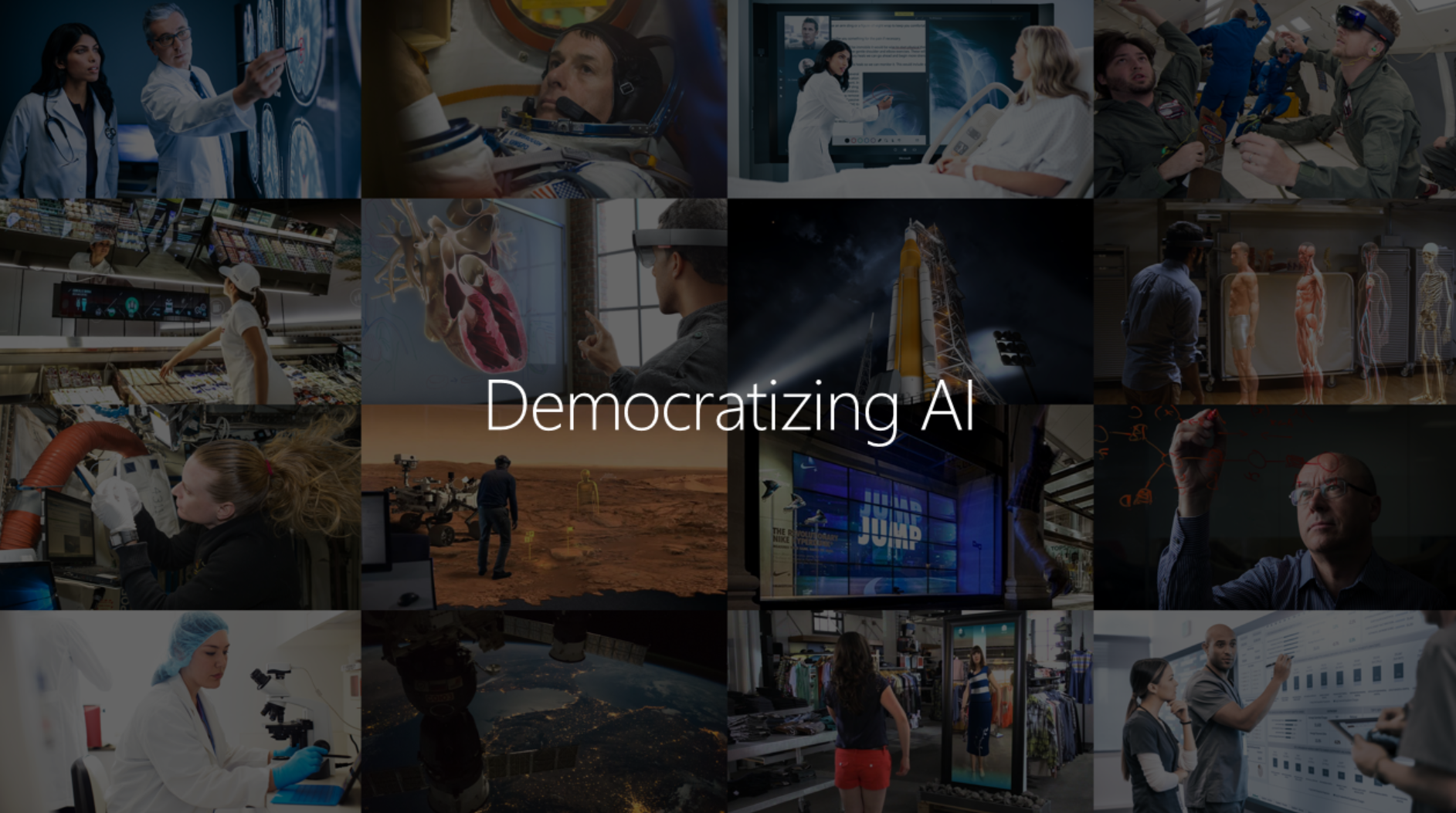
Democratizing AI
For every person and every organization
As we think about the future of technology, it resides in the notion of intelligence. At Microsoft, we have an approach that’s both ambitious and broad, an approach that seeks to democratize Artificial Intelligence (AI), to take it from the ivory towers and make it accessible for all.
And as we consider the future, it’s often instructive to look to the past. Let’s consider the beginning of the modern era of information. With the advent of the printing press in the 1400s we have an explosion of information — the first democratizing event around access that made it possible for humans everywhere to start learning.
Access to information has only spread from there. Every walk of life has changed because of our ability to create knowledge and distribute knowledge. But one thing has remained constant and scarce: time.
In the midst of this abundance of information, we’re still constrained by our human capacity to absorb it.
The question is, how can we use all we have in terms of computational power to solve this fundamental constraint? To make better sense of the world? That’s the essence of what AI is. It’s not about having AI that beats humans in games, it’s about helping everyone achieve more — humans and machines working together to make the world a better place.
We’re taking a four-pronged approach to how we think about Microsoft AI and how we pursue this bold ambition to democratize AI for all:
- We’re going to harness artificial intelligence to fundamentally change how we interact with the ambient computing, the agents, in our lives.
- We’re going to infuse every application that we interact with, on any device, at any point in time, with intelligence.
- We’ll make these same intelligent capabilities that are infused in our own apps — the cognitive capabilities — available to every application developer in the world.
- We’re building the world’s most powerful AI supercomputer and making it available to anyone, via the cloud, to enable all to harness its power and tackle AI challenges, large and small.
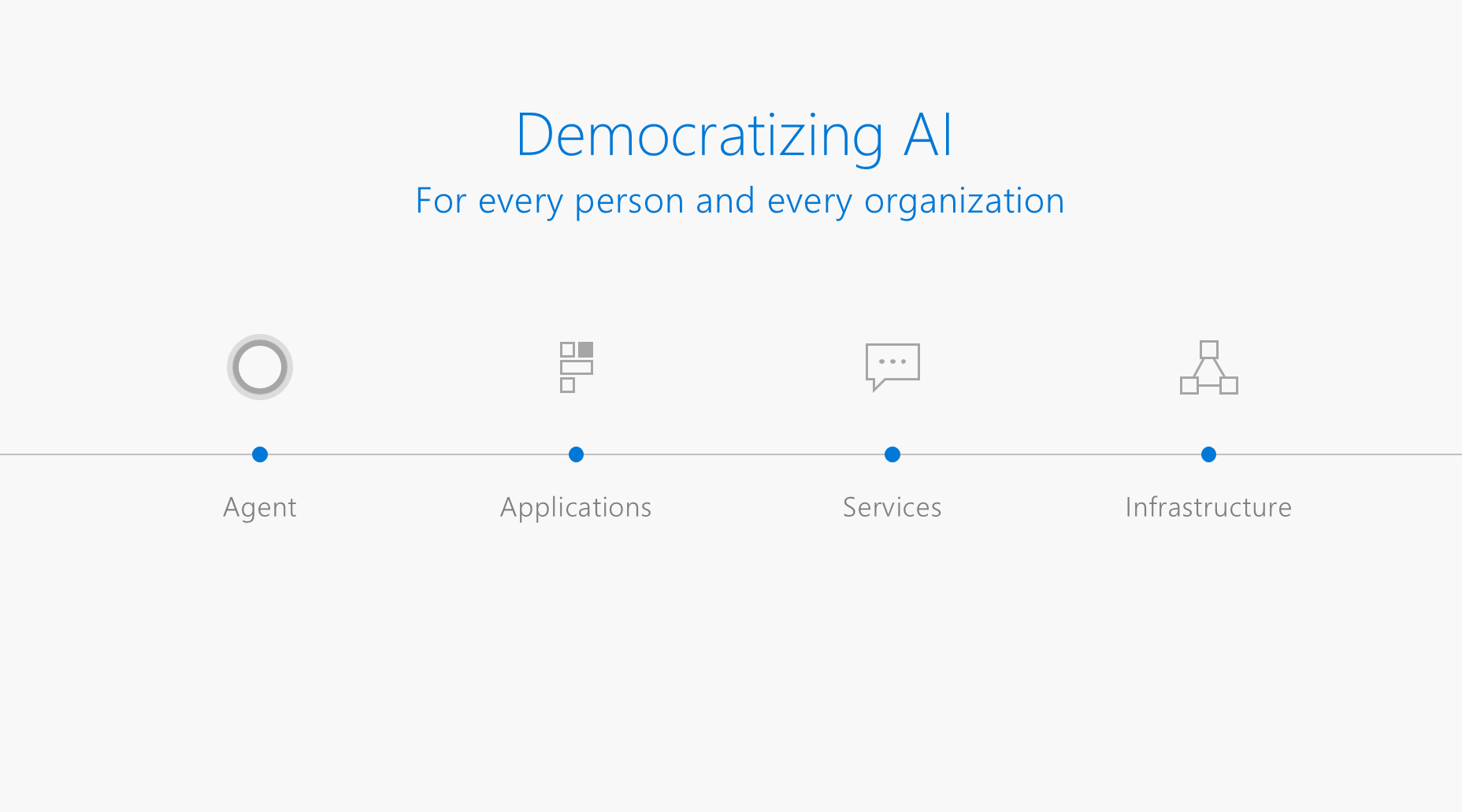
Where we are today…
There have been 12 billion queries or questions asked of Cortana, an agent that has over 133 million active users today. She is becoming smarter about the world, and becoming smarter in terms of her understanding of you, the world around you, and importantly, the ability to put that information into context.
Cortana works across devices. And there is an ecosystem effect with the skills she’s developing to surface information about your daily tasks in work and life, often before you know you need it.
We are also building applications that are core to your productivity and communication, as well as business processes — and we’re infusing them with intelligence.
Applications such as Microsoft Pix, for example, a photo editing tool with the power of perception that helps you choose the perfect image, every time.
MileIQ is a location-aware app with intelligence that helps you quantify and categorize travel with ease, and has logged 11 billion miles to help millions reclaim $1.2 billion.
SwiftKey is a smart keyboard that uses a neural network, trained for how you type words, to model the next word you want to type, making even this basic task more intelligent. And it’s not bound by platform. SwiftKey is being used by 300 million Android and IOS devices, has learned from 10 trillion keystrokes and saved 100,000 years of time.
In Office 365, My Analytics is like a fitness tracker for your workday, showing how you’re spending your time informed by the Microsoft Graph and powered by AI.
In addition to infusing intelligence into your daily interaction with applications, we’re also taking the notion of what a customer relationship management (CRM) application is and turning it upside down. CRM systems have historically been built as siloed systems that modeled customer activity in explicit terms, built for management, not for sales productivity.
What if salespeople had the ability to act on information based on the activities of customers happening outside their CRM system: on Twitter, in Facebook, in customer service applications. We will enable salespeople to take action in an integrated way using a rich data model that can infer intelligence from everywhere.
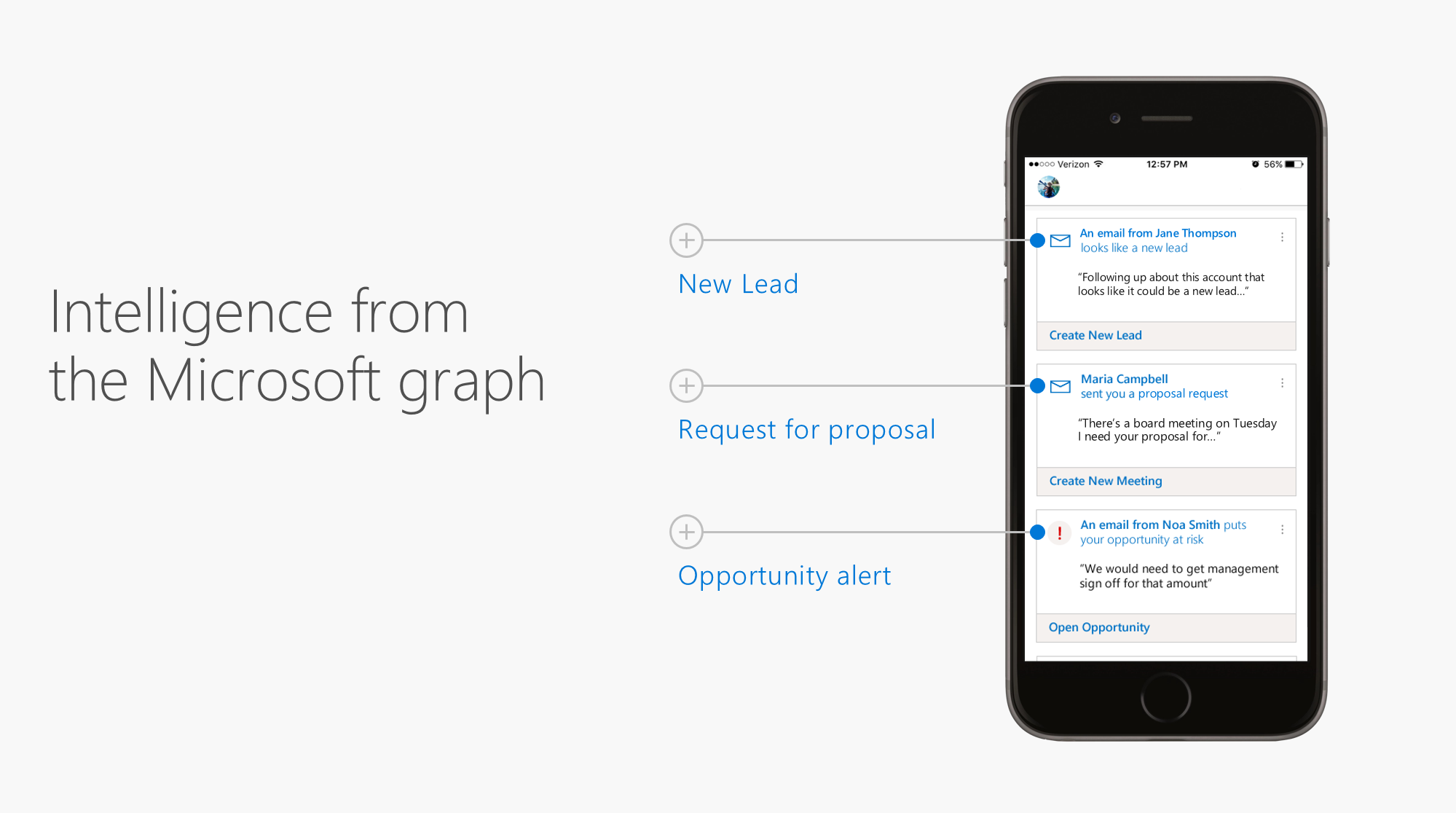
Another area that we are experimenting with is the intelligent agent, a virtual assistant that troubleshoots your issue, while at the same time learns from your questions much like a search engine would.
Agents can now acquire information using reinforcement learning capabilities, a breakthrough that is going to improve these virtual assistants and forever change the economics of customer service.
As we infuse intelligence into everything, whether it’s your keyboard, your camera, or business applications, we are essentially teaching applications to see, to hear, to predict, to learn and take action.
We aim to take that same capability and made it available as a set of APIs to every developer and democratize it so that everyone can use the same building blocks that we use to build Office, Cortana and Dynamics 365.
The first building block around machine learning and advanced analytics is Cortana Intelligence Suite. And it’s showing up in a variety of industries — including healthcare, personalized medicine and agriculture — with customers like Ecolab, Schneider Electric and Rolls-Royce.
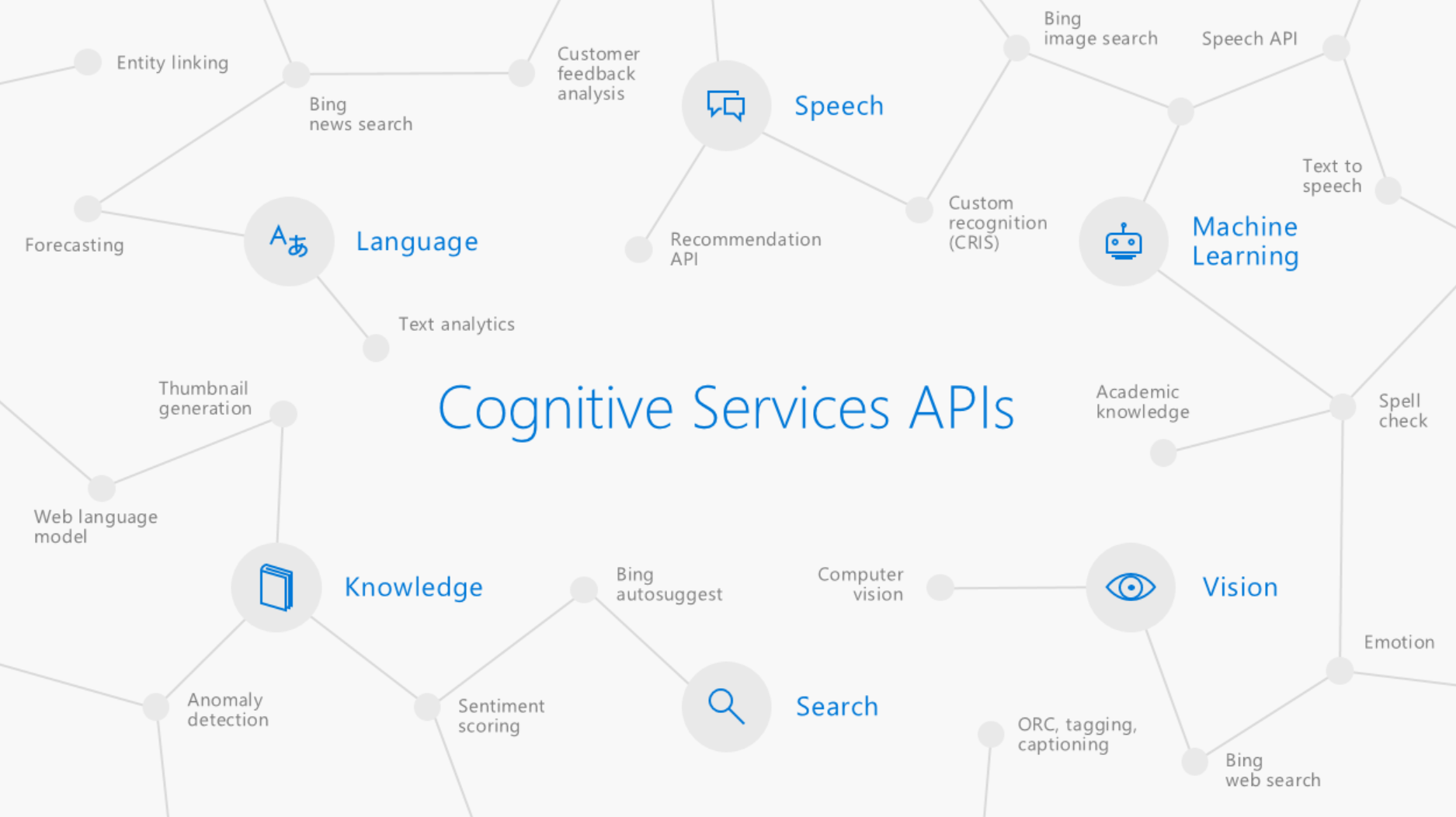
Another platform is the Bot Framework, a toolkit that allows you to build intelligence into these new kinds of applications — 40,000 developers have used it since our Build event — as well as brands like Uber, which uses face recognition APIs in Cognitive Services to enhance their mobile applications, and ensure passenger safety.
Imagine having a device like HoloLens and marrying it with the cognitive capabilities in Azure, and the preference graphs in services like Pinterest. Lowe’s is taking this union and reimagining how home remodeling works.
Before, you would go to the store, pick out designs and samples, head back home, look at them, tweak them, go back to the store, change, rinse and repeat. With machine learning and HoloLens, you can go to a retail outlet, recreate your remodel in front of your eyes, get the design you want and place your order.
This is transformative, not just for retailers, but for their customers too.
All of this is possible because of the foundational availability of computing resources that allow us to reason large amounts of data, but we’re taking it a step farther.
AI services require a different type of technology. To achieve this, we’ve put a large number of FPGAs (Field-Programmable Gate Arrays) in our cloud, which can talk to the network directly. FPGAs are programmable hardware, which means you can have efficiency and speed, but also flexibility.
Today we have a global, hyperscale, cloud infrastructure that we continue to improve across many dimensions – performance, scale and increasing richness and sophistication of higher level services to enable scenarios that simply were not possible before. We’ve added GPUs to that cloud to deliver the highest performance cloud available.
Customers such as Jellyfish Pictures and Virginia Tech are using CPU-based virtual machines to dramatically scale production needs, on demand. We’re adding FPGAs to deliver unprecedented network performance in this cloud that improves throughput for all workloads, including running mission-critical applications like SAP.
It’s an incredible platform for doing AI work too. We support all the frameworks for AI — our own, CNTK, is the fastest distributed framework for neural networks and the only public toolkit that can scale beyond a single machine — but also TensorFlow, Caffe and Torch.
All of that is available today at unprecedented scale. But we’re not stopping there. Azure is now the world’s first AI supercomputer. Put another way, we’re looking post-Moore’s-Law — and solving for the issue of Moore’s Law running out of steam.
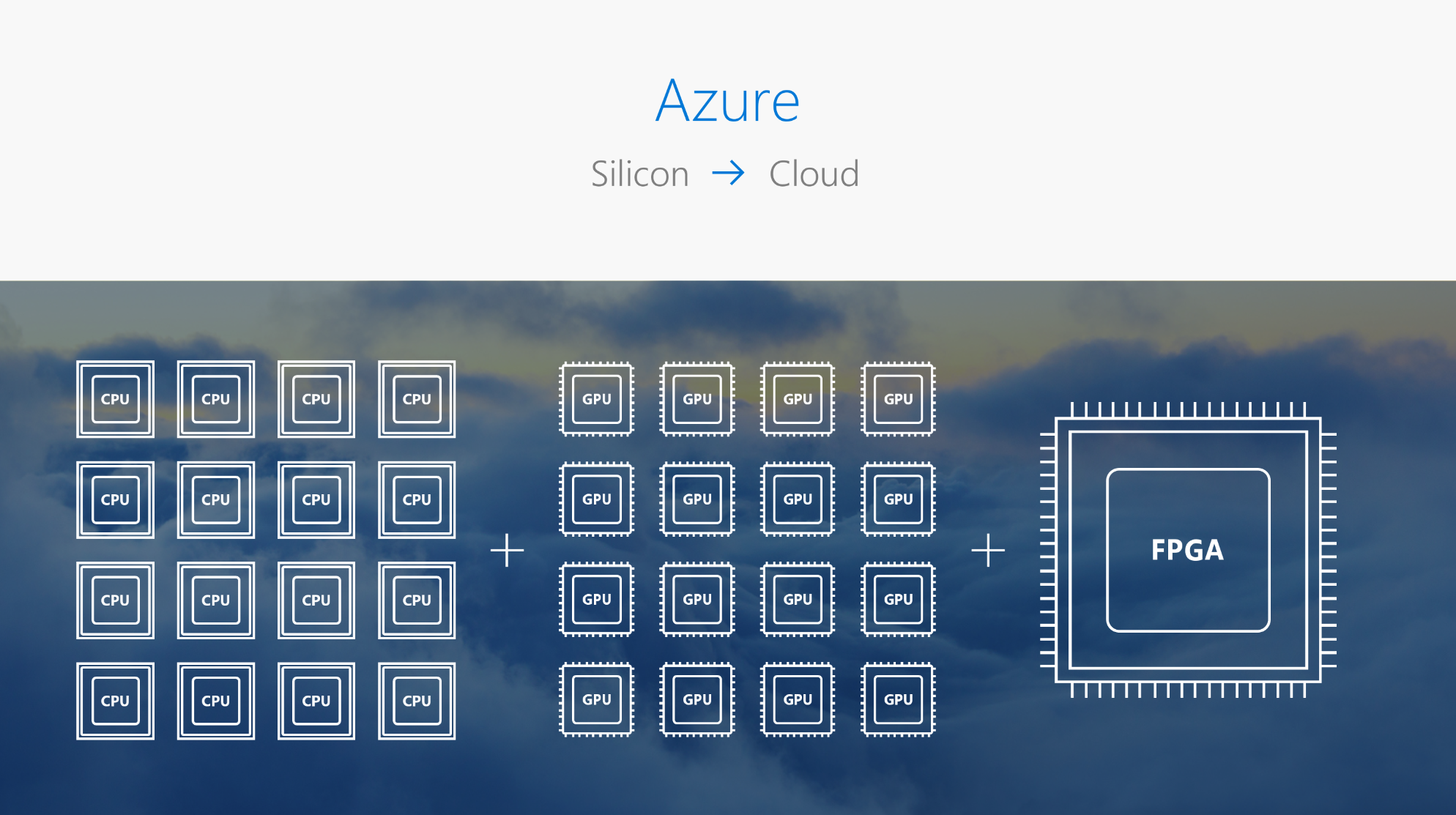
By adding this technology to the cloud, we can do amazing things. Consider translation as one example. Using just a single node of our FPGA fabric we can translate War and Peace, all 1440 pages, from Russian to English in just two and a half seconds.
If we take the entire capability today, the AI supercomputer can translate all of Wikipedia— which printed and stacked on end would stand a quarter mile high — in less than one tenth of a second, less time than it takes you to blink once.
The same set of FPGA nodes on our fabric could also translate the Library of Congress, about 38 million books, in 76 seconds — about the time it takes you to walk and get a cup of coffee at work.
Azure is using this technology for accelerated networking and for a virtual machine that can drive 25 gigabits per second throughput at a 10X reduction in latency. Every time you do a Bing query, you’re touching this fabric to get better results.
We have the world’s most-powerful cloud, we have the world’s most-intelligent cloud and we have the world’s most-flexible cloud.
But it’s important as creators of technology for us to make careful choices so that this technology ultimately translates into welfare for all, and that means design principles that focus on the human benefit of AI, transparency and accountability.
It’s not just about celebrating new technology, it’s about the human ingenuity and human passion being brought together with amazing new technology to go and tackle some of the fundamental challenges of humanity.
Today, we are only scratching the surface of what AI can help us accomplish. Ultimately, we believe humans and machines will work together to solve society’s greatest challenges, to create magical experiences and change the world.
